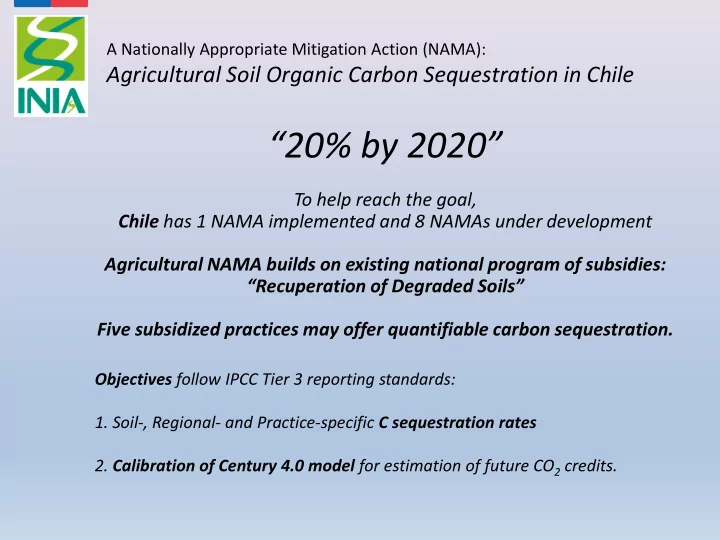

A Nationally Appropriate Mitigation Action (NAMA): Agricultural Soil Organic Carbon Sequestration in Chile “ 20% by 2020 ” To help reach the goal, Chile has 1 NAMA implemented and 8 NAMAs under development Agricultural NAMA builds on existing national program of subsidies: “Recuperation of Degraded Soils” Five subsidized practices may offer quantifiable carbon sequestration. Objectives follow IPCC Tier 3 reporting standards: 1. Soil-, Regional- and Practice-specific C sequestration rates 2. Calibration of Century 4.0 model for estimation of future CO 2 credits.
Methods Comparisons of Practices: • Subsidized Practices vs. Competing Anterior Practices • All sites are paired with neighbor for comparison. • 15-20 pairs per practice • Minimum 5 pairs per Soil-Climate combination • ≥ 5 years application • on sites with slope < 10% to avoid erosion factor Statistics Linear Mixed Effects Model Based on Brazilian SOC study by Mello et al. ( Nature , 2014). Site pairing ensures balanced dataset and allows modeling. Statistical Variables: SOC, total N, extractable P, soil texture, zone, length of practice Modeling Variables: SOC, total N, extractable P, soil texture, extractable ammonium and nitrate, water retention curve, management history (fert, crops, soil)
Comparisons of Practices Subsidized Comparison Geographical Notes Practice Practice Zone(s) Improved Unimproved Coastal Range Long-term systems without Pasture: P “Natural” Pasture and South irrigation amendments and Clover mixes Crop Residue Burning or Straw Central Valley Irrigated Incorporation Removal, depending on Region Zero Tillage Natural Pasture Andean Includes occasional foothills and subsoiling or shallow South incorporation; unirrigated Compost in crops, Similar crops Central Valley Focus on organic farmers; primarily under sub-urban current subsidy pays for vegetables conventional (close to finished product; irrigated fertilization markets) Stabilized poultry Similar crops Currently Study required on further manure in crops under northern available resources; conventional coastal range unirrigated fertilization
Results: Possible Policy Effects Potential NAMA Effects: • Credit for Chile in meeting GHG reduction goals • Assistance for Chile in development of (Tier 3) modeling program: I. Organizational Support II. Policy Revision III. Further research as needed IV. Improved soil maps/data V. Improved climate data VI. Integration with global C Seq modeling efforts Domestic Effects : • Transition from Burning to Incorporation • Assistance to Smallholder Livestock • Long-term Pasture-Crop (Zero Tillage) Rotations • Compost in Organic Systems and Smallholder Farms
Instituto de Investigaciones Agropecuarias INIA Cropland Research Group Meeting Santiago, 17 y 18 de Junio de 2015
Recommend
More recommend